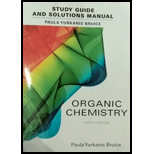
a)
Interpretation:
The product of the given reaction has to be drawn.
Concept Introduction:
The synthesis of target molecules:
The synthesis of a target molecule relies upon the type of reactants and reagents that are used during the reactions. The energy of a target molecule should be low because it increases the stability of a molecule that results in the formation of a high yield of the product. The reagents perform numerous functions in the reactions like proton abstraction, oxidation, reduction, catalysis, and dehydrogenation.
b)
Interpretation:
The product of the given reaction has to be drawn.
Concept Introduction:
The synthesis of target molecules:
The synthesis of a target molecule relies upon the type of reactants and reagents that are used during the reactions. The energy of a target molecule should be low because it increases the stability of a molecule that results in the formation of a high yield of the product. The reagents perform numerous functions in the reactions like proton abstraction, oxidation, reduction, catalysis, and dehydrogenation.
Want to see the full answer?
Check out a sample textbook solution
Chapter 18 Solutions
Student's Study Guide and Solutions Manual for Organic Chemistry
- Metal clusters and catalytic processes.arrow_forwardMetal clusters and catalysis.arrow_forwardQ1: Draw a valid Lewis structures for the following molecules. Include appropriate charges and lone pair electrons. If there is more than one Lewis structure available, draw the best structure. NH3 Sulfate Boron tetrahydride. C3H8 (linear isomer) OCN NO3 CH3CN SO2Cl2 CH3OH2*arrow_forward
 Organic ChemistryChemistryISBN:9781305580350Author:William H. Brown, Brent L. Iverson, Eric Anslyn, Christopher S. FootePublisher:Cengage Learning
Organic ChemistryChemistryISBN:9781305580350Author:William H. Brown, Brent L. Iverson, Eric Anslyn, Christopher S. FootePublisher:Cengage Learning

